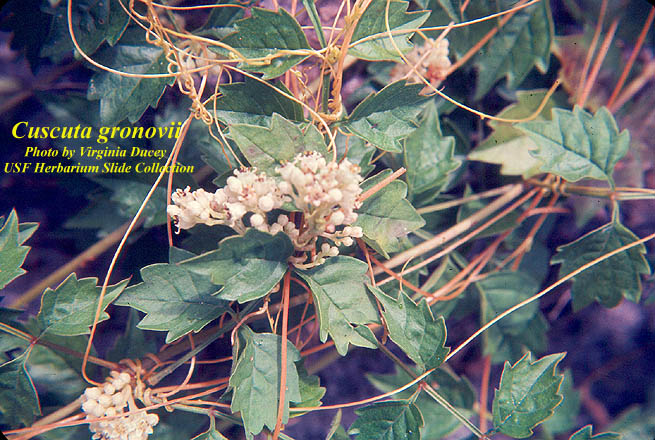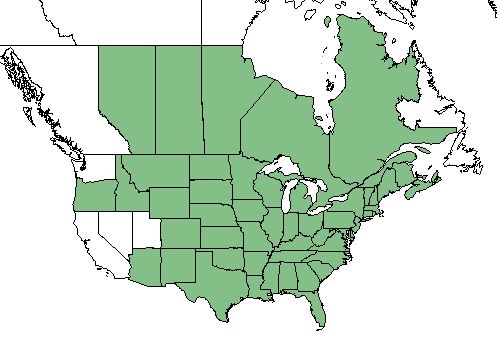Cuscuta gronovii
| Cuscuta gronovii | |
|---|---|

| |
| Photo by the Atlas of Florida Plants Database | |
| Scientific classification | |
| Kingdom: | Plantae |
| Division: | Magnoliophyta - Flowering plants |
| Class: | Magnoliopsida - Dicots |
| Order: | Solanales |
| Family: | Cuscutaceae |
| Genus: | Cuscuta |
| Species: | C. gronovii |
| Binomial name | |
| Cuscuta gronovii Willd | |

| |
| Natural range of Cuscuta gronovii from USDA NRCS Plants Database. | |
Common Name: swamp dodder; common dodder;[1] scaldweed[2]
Contents
Taxonomic Notes
Synonym: Grammica gronovii[1]
Varieties: C. gronovii var. gronovii;[1][2] C. gronovii var. latiflora;[1] C. gronovii var. calyptrata[2]
Description
C. gronovii is a dioecious perennial that grows as a forb/herb or vine.[2] Scales can produce up to five axillary branches, which can then become their own plant after contacting a host.[3] Its seeds weight 2.3 g and is reported to have 22,900 seeds in a single clump.[4] Other dodder species have a very limited photosynthetic ability that decreases with age. It is likely C. gronovii is similar in this regard.[5]
Distribution
This species is found in all of the lower 48 United States except for Washington, California, Nevada, and Utah. It is also found in Canada from Alberta eastward to Quebec, New Brunswick, and Nova Scotia.[2]
Ecology
Habitat
This species is found on a wide variety of herbaceous and woody plants within stream banks, bottomland forests, bogs, marshes, swamps, wet fields, and wet disturbed areas.
Phenology
Flowering occurs from late July through November in the southeastern and mid-Atlantic United States.[1]
Seed bank and germination
Seeds germinate in soil, but roots die off as the plant twines around a host and sends out suckers that penetrate the host's tissues and obtain nutrients.[6] Embryogenesis studies reveal no primary root meristem in this species.[3]
Conservation and Management
Cultivation and restoration
Photo Gallery
References and notes
- ↑ 1.0 1.1 1.2 1.3 1.4 Weakley AS (2015) Flora of the Southern and Mid-Atlantic States. Chapel Hill, NC: University of North Carolina Herbarium.
- ↑ 2.0 2.1 2.2 2.3 2.4 USDA NRCS (2016) The PLANTS Database (http://plants.usda.gov, 25 January 2018). National Plant Data Team, Greensboro, NC 27401-4901 USA.
- ↑ 3.0 3.1 Truscott FH (1966) Some aspects of morphogenesis in Cuscuta gronovii. American Journal of Botany 53(7):739-750.
- ↑ Stevens OA (1957) Weights of seeds and numbers per plant. Weeds 5(1):46-55.
- ↑ Pattee HE, Allred KR, Wiebe HH (1965) Photosynthesis in dodder. Weeds 13(3):193-195.
- ↑ Plant database: Cuscuta gronovii. (25 January 2018) Lady Bird Johnson Wildflower Center. URL: https://www.wildflower.org/plants/result.php?id_plant=CUGR